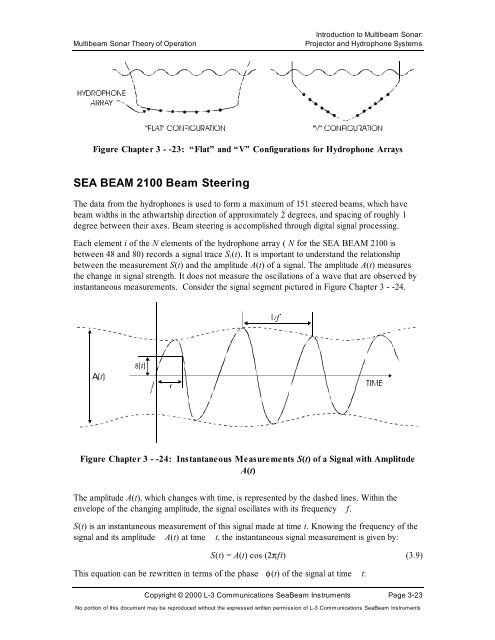Multibeam Sonar Theory of Operation
Multibeam Sonar Theory of Operation
Multibeam Sonar Theory of Operation
You also want an ePaper? Increase the reach of your titles
YUMPU automatically turns print PDFs into web optimized ePapers that Google loves.
Introduction to <strong>Multibeam</strong> <strong>Sonar</strong>:<br />
<strong>Multibeam</strong> <strong>Sonar</strong> <strong>Theory</strong> <strong>of</strong> <strong>Operation</strong> Projector and Hydrophone Systems<br />
Figure Chapter 3 - -23: “Flat” and “V” Configurations for Hydrophone Arrays<br />
SEA BEAM 2100 Beam Steering<br />
The data from the hydrophones is used to form a maximum <strong>of</strong> 151 steered beams, which have<br />
beam widths in the athwartship direction <strong>of</strong> approximately 2 degrees, and spacing <strong>of</strong> roughly 1<br />
degree between their axes. Beam steering is accomplished through digital signal processing.<br />
Each element i <strong>of</strong> the N elements <strong>of</strong> the hydrophone array ( N for the SEA BEAM 2100 is<br />
between 48 and 80) records a signal trace Si(t). It is important to understand the relationship<br />
between the measurement S(t) and the amplitude A(t) <strong>of</strong> a signal. The amplitude A(t) measures<br />
the change in signal strength. It does not measure the oscillations <strong>of</strong> a wave that are observed by<br />
instantaneous measurements. Consider the signal segment pictured in Figure Chapter 3 - -24.<br />
Figure Chapter 3 - -24: Instantaneous Measurements S(t) <strong>of</strong> a Signal with Amplitude<br />
A(t)<br />
The amplitude A(t), which changes with time, is represented by the dashed lines. Within the<br />
envelope <strong>of</strong> the changing amplitude, the signal oscillates with its frequency f.<br />
S(t) is an instantaneous measurement <strong>of</strong> this signal made at time t. Knowing the frequency <strong>of</strong> the<br />
signal and its amplitude A(t) at time t, the instantaneous signal measurement is given by:<br />
S(t) = A(t) cos (2πft) (3.9)<br />
This equation can be rewritten in terms <strong>of</strong> the phase φ(t) <strong>of</strong> the signal at time t:<br />
Copyright © 2000 L-3 Communications SeaBeam Instruments Page 3-23<br />
No portion <strong>of</strong> this document may be reproduced without the expressed written permission <strong>of</strong> L-3 Communications SeaBeam Instruments
















